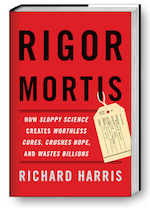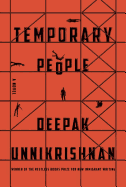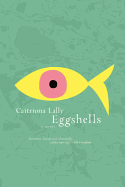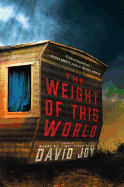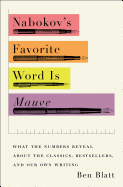 |
| photo: Meredith Rizzo |
Richard Harris has served as a science journalist with National Public Radio (NPR) for the past 30 years. He's covered a wide range of topics from medicine to the environment, and he's traveled to all seven continents. His favorite places include the South Pole and Greenland. "Ice is simply beautiful," he says. Harris lives in Washington, D.C., and is a three-time winner of the AAAS Science Journalism Award. Rigor Mortis (Basic Books) is his first book.
Tell us about your science background.
I have an undergraduate degree in biology, which is how I first learned about biology, genetics, biochemistry and--most importantly--the scientific method. As a college student, I discovered that I loved learning about science, but I didn't particularly enjoy life in the lab.
Therefore, writing?
Science journalism was the perfect career for me. I started it right out of college with a fellowship, then a job at a small newspaper. I never looked back. My perch in journalism provides me the perfect vantage point to keep learning and watching as scientific knowledge evolves. Of course, the world has changed a lot since my degree more than 30 years ago.
Why a book about biomedical research?
In 2014, my beat at NPR shifted to biomedical research. In the course of orienting myself to the lay of the land since I'd last reported on these topics, I discovered some unfortunate trends--especially a push toward hyper-competitiveness as more scientists found themselves vying for a shrinking pool of resources. I started to explore the impact of that on research and realized there was a book's worth of material. At the same time, scientists were increasingly becoming concerned that many research results couldn't be reproduced in other laboratories. The two issues are deeply connected.
The book offers a plethora of information.
I had an outline going into the project, but of course it morphed as I did the reporting for the book. I knew from the outset that I wanted to explore the various reasons behind the lack of rigor in biomedical research, starting with dubious ingredients, and including unconscious bias, poor use of statistics and the perverse incentives in biomedicine right now (driven by the struggle for funding). I also wanted to take time to explain how science really works, and why failure is an inevitable--even beneficial--part of it. I also kept my eye out for scientists who were exploring ways to address these problems.
Did you learn anything surprising in writing the book?
Going into the project, I thought scientists might be reluctant to talk to me about the less-than-flattering issues confronting their profession. I was surprised that was not the case--almost everyone was eager to talk, not only about what's wrong, but why. As a reporter, I had been aware of the power dynamics within science, but those issues were generally peripheral to whatever specific topic I was covering, not the focus of my reports. The book gave me an opportunity to look at these issues directly--and to talk about them with some of the nation's most talented and influential scientists.
Would you say that money is the driving force in the biomedical industry?
Money plays an important role, but it's not the only driving force. I think far too often scientists become enamored with their own ideas and look for ways to bolster their theories instead of looking for ways to challenge them. That's absolutely human nature; we all do that, often unconsciously. But science, when done properly, is supposed to be a system that prevents people from fooling themselves. It works in the long run, but not so well in the short run.
You state that the "rate of new-drug approval has been falling since the 1950s." Is this a result of the biomedical community or the FDA?
This is not at all a problem of bureaucracy. The FDA drug approval process has never been faster. Part of the reason for the slow pace is that drug companies solved some of the easy problems early on, and now they're working on harder ones. You know the cliché about low-hanging fruit--well, it applies here. Another problem is drug companies largely stopped doing their own basic research and have come to rely heavily on academic science for leads. When academic scientists produce results that drug companies can't reproduce, that leads to false starts and wasted effort. That phenomenon contributes to the downward trend in new-drug development as well.
How could biomedical science be improved?
It could be much improved if researchers spent more time questioning their own beliefs. Unfortunately, the competitive nature of science and science funding often provides a disincentive for scientists to say, "maybe I'm wrong."
Rigor Mortis underscores the fierce competition and politics (on all levels) prevalent in the biomedical research field.
Competition has become fiercer--and for good reason. A decade ago, about 30% of NIH (National Institutes of Health) grants got funded; today it's about half that, due to an increase in scientists seeking money and a 20% decrease (adjusting for inflation) in the amount of funding available. Scientists are locked in an unhealthy struggle. Unfortunately, young scientists who may have the freshest ideas are often the ones edged out in this competition. They leave the world of research to the senior investigators who are able to draw funding because of their reputations. At this point, there's little hope of infusing enough new money into science to right this imbalance. These deep structural problems have no obvious solutions. It's going to get worse before it gets better.
Does that mean you're pessimistic about the future of biomedical research?
Despite the lugubrious title of my book, I'm optimistic about the problems I write about. No scientist wants to waste his or her time, and the community as a whole is becoming aware of its flaws. There were similar problems with medical studies involving human volunteers in earlier times. During the 1990s, scientists and funders turned their attention toward those issues and have made significant improvements (of course, there's always room for more) in the conduct of clinical research. The same can easily happen in biomedical research if the right incentives are put in place.
Who is the ideal reader for this book?
Rigor Mortis is written for the same audience that listens to NPR's science reporting--people who are curious about the world around them and who want a deeper understanding of how the scientific enterprise works. Science has been a driving force in our lives, helping us to understand the remarkable world we live in, while providing us technologies that make our lives better. This book is for people who want to understand the very human process behind all that wonder. I also hope that scientists who are trying to figure out how to make their enterprise more productive and less error-prone will find insights in reading Rigor Mortis.
Did any books inspire you in writing Rigor Mortis?
One of the greatest joys about writing a book was having the time to read other books along the way. I drew inspiration from The Invention of Science: A New History of the Scientific Revolution by David Wootton; Willful Ignorance: The Mismeasure of Uncertainty by Herbert Weisberg; Failure: Why Science Is So Successful by Stuart Firestein; A Conspiracy of Cells by Michael Gold; The Rise and Fall of Modern Medicine by James Le Fanu; and Consilience: The Unity of Knowledge by E.O. Wilson. --Kathleen Gerard
Richard Harris: The Lack of Rigor in Biomedical Research
 Whereas by Layli Long Soldier: "In this searching, plaintive poetry collection, Native American poet Layli Long Soldier digs deep into the often unseen strata of language, history and identity. Whereas beautifully upends poetic forms to summon a powerful voice hidden in the interstices." --Scott Neuffer
Whereas by Layli Long Soldier: "In this searching, plaintive poetry collection, Native American poet Layli Long Soldier digs deep into the often unseen strata of language, history and identity. Whereas beautifully upends poetic forms to summon a powerful voice hidden in the interstices." --Scott Neuffer 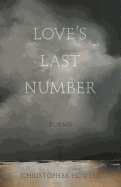 Love's Last Number by Christopher Howell: "A former war journalist's elegant and profound poems use awe-inspiring imagery to answer some of the greatest questions of human existence. Love's Last Number showcases a visionary mind and serves as a testament to the power of imagination in connecting human beings to each other." --Scott Neuffer
Love's Last Number by Christopher Howell: "A former war journalist's elegant and profound poems use awe-inspiring imagery to answer some of the greatest questions of human existence. Love's Last Number showcases a visionary mind and serves as a testament to the power of imagination in connecting human beings to each other." --Scott Neuffer There Are More Beautiful Things Than Beyoncé by Morgan Parker: "Morgan Parker tackles weighty issues with deft wit and powerful candor in There Are More Beautiful Things Than Beyoncé. Her insightful and irreverent collection turns a sharp eye toward a broad collage of subjects, including her muse Beyoncé, the Obamas and historical figures like the so-called Hottentot Venus." --Katie Weed
There Are More Beautiful Things Than Beyoncé by Morgan Parker: "Morgan Parker tackles weighty issues with deft wit and powerful candor in There Are More Beautiful Things Than Beyoncé. Her insightful and irreverent collection turns a sharp eye toward a broad collage of subjects, including her muse Beyoncé, the Obamas and historical figures like the so-called Hottentot Venus." --Katie Weed Madwoman by Shara McCallum: "Memory, fable and family history feature strongly in Shara McCallum's fifth collection of poetry. Sprinkled throughout with poems written in Jamaican patois, McCallum uses changes in language and structure--traditional poetic forms, lists, question-and-answer dialogues--expertly to reveal and question limits in the knowledge of self." --Richael Best
Madwoman by Shara McCallum: "Memory, fable and family history feature strongly in Shara McCallum's fifth collection of poetry. Sprinkled throughout with poems written in Jamaican patois, McCallum uses changes in language and structure--traditional poetic forms, lists, question-and-answer dialogues--expertly to reveal and question limits in the knowledge of self." --Richael Best


